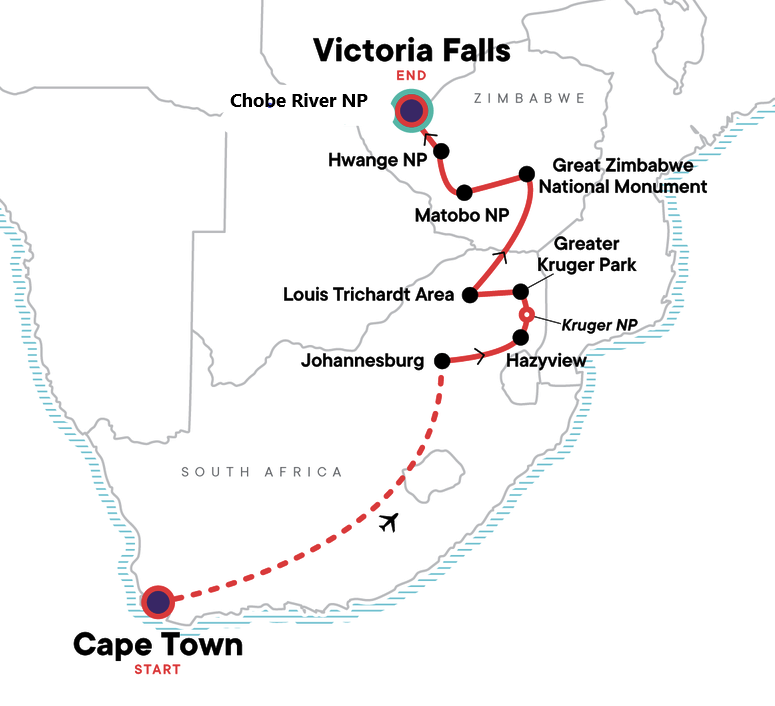

Why South Africa
Why holiday in Africa? Well apart from the unique opportunity to view its abundant wildlife was the prospect of seeing firsthand the progress that both South Africa and Zimbabwe had made in cultivating democratic changes since the abolition of their respective apartheid regimes from the mid-1980s. In addition, it would give us an opportunity to just feel the vibe of southern Africa's people, their rhythms, music and food - it was after all a whole new continent to begin exploring.
After such grand expectations, our trip did not disappoint albeit the whirlwind timeframe of our chosen tour. It took a while to appreciate that we were exploring the southern tip of a vast land mass and not some regional tourist enclave as we have previously visited all over Asia. Visiting Australians especially from Queensland will notice many similarities in the prevailing climate as it shares the same latitudes (18 to 34 degrees South) as ourselves. It also shares a lot of common topography and vegetation with our own sparse woodlands mixed with open savanna grasslands. Much of the non-cultivated lands are covered in a varieties of acacia shrubs much appreciated by the herbivorous wildlife species.
The southern winter months (June through to September) are the recommended months for wildlife safaris as the wildlife can more readily be sighted in the thinned-out vegetation cover as well as by their need to congregate around the shrinking size and number of waterholes and soaks. Be warned, the overnight temperatures during these months can drop to single Celsius figures and blankets are frequently distributed to those choosing to participate in early morning or late evening expeditions in open 4x4 vehicles.
The options for going 'on safari' in southern Africa would appear limitless and costs vary from A$150 to $1500+ per night. This would range from camping in National Park reserves to luxe private safari lodges located within private game concessions leased from the national park authorities or directly from other tribal lands - your choice is limited by your own budget. While the wildlife to view would be pretty much the same, your accommodation, vehicle comfort, and size of safari group would be much more amenable. Of course, central to any successful safari is the presence of a knowledgeable and competent guide who can not only get you to various wildlife but also to tell you a little about them, their management and relevant conservation measures being taken to protect them.
Safaris to Kenya and Tanzania and into the Serengeti National Park cost more because of more expensive safari accommodation options and airfares - but you can incorporate a side trip to the old slave trading island of Zanzibar which sounded awesome.
Our own safari was run by the Canadian travel company G Adventures (the same firm we had used to travel around China in 2016). G Adventures offer no frills 'flash packer' traveling to ‘off the beaten path’ destinations in a variety of countries – using locals as their Chief Experience Officers (CEOs) as well as local services wherever possible. Their formula includes all travel, accommodation and entry fees but few meals – they prefer instead to get you to share meals with the tour group at venues chosen by the CEO and split the costs. The standard of travel can be characterised as Three Star with accommodation offerings being a mix of small scale older safari lodges serving English pub (budget) meals in the game parks as well as some recently renovated 'tourist hotels' in both central Cape Town and Johannesburg and a 'ritzy' (3.5 Star) hotel in Victoria Falls......we were not offered any luxe options and forced to accept the odd cramped and dusty room and the indignity of one-two ply toilet paper! However, the biggest disappointment was the lack of variety in the meal offerings - too many similar meals presented warm not hot in Bain maries
Other considerations when traveling to South Africa include the required suite of vaccinations including Cholera, Typhoid, Hepatitis A, Malaria and Tetanus (and all Covid jabs on offer) and the airfare costs whether or not you choose QANTAS or Singapore Airlines - it’s almost the same as return tickets to London. I did flirt with the idea of flying Premium Economy until I found out it costs an additional 50-150% on top of the Economy fare. Long haul economy does become much harder as you age - they do squeeze you up on those large long-range jets - we flew via Singapore and I could barely open up the meal table in front of me even with the seat in front being fully up right......that's right 2 x 10hr flights with not a sandwich space between me and row in front.
Our tour group of 12 comprised a couple of newly minted university graduates from the UK (Abigail and Tara), three middle aged Polish people, four retired Irish primary school teachers (Geraldine, Creena, Joan and Sarah), an aged-care support professional from Cairns (Leah) and ourselves. Because of linguistic difficulties, the three Polish travellers tended to keep to themselves apart from a lot of the joint activities: especially at mealtimes and evening drinks. Despite our ages the rest of us quickly formed into a great team. Our team leader or Chief Expedition Leader was Gert (GP) Wentzel a long-term native Afrikaner from Cape Town who proved to be an excellent shepherd and advisor to our tour group. He certainly made the tour for us with his extensive background knowledge of the history of the countries travelled, their political problems, the social and economic legacies of apartheid and was also a keen wildlife conservationist. He was an astute and often humorous storey-teller providing valuable in-depth explanations to the myriads of questions put to him. GP was our 'go to man'.
This tour necessarily involved a number of long hours of daily travel (5-7 hours) in our dedicated 22 seat Coaster bus. I do believe that this time could have been made rewarding had our CEO instituted a firm rotation of the group members; especially so everyone could have shard the prime front seats not only to better interrogate him of occasional points of interest but also to be better positioned to take photographs. It was a little disappointing to notice a number of travel-weary members in rear seats succumbing to their hand-held devices to access social media and even games rather than actively noting the African scenery and life going past. I believe the distribution of occasional fact sheets, maps or pamphlets would have added enrichment to our experience. Here again, younger travellers might claim that they had access to all the information they needed from Mr Google sitting in their laps.
I should record that GP went well beyond his official remit to assist Maria's participation in as many activities as she comfortably could during the tour.
Potted History of Cape Colonies
Our tour began in the city where South Africa's European roots first took hold. Cape Town lies just 80kms North from the actual Cape of Good Hope (34.3 degrees south latitude cf Adelaide 34.9 degrees south latitude). The Cape's first recorded rounding by Europeans occurred in 1480s by Portuguese searching for quicker routes to the East Indies, but it was the Dutch East India Company which first established a permanent settlement here in 1652. For the next 150years it flourished as a major trading port and centre for the slave trade. Then it was Britain's turn who ruled the Cape Colony and its town for the next 120 years.
The British did little to develop its South African colony until the discovery of the world's largest deposit of diamonds in the 1860s, followed by massive gold deposits in the 1880s. It finally took their successful war against an up-rising of the local Dutch Afrikaner (Boer's) population to gain administrative cohesion for the Colony. In 1910 South Africa was was finally granted its independence. Apartheid policies introduced soon after and remained in place until 1994 when Nelson Mandela's ANC party wins the national election and introduces democracy for first time.
Cape Town (population 4.9m)
Our long (12 hr) plane trip from Singapore was broken by a short -refuelling stop just on Sunrise in Johannesburg, Almost 70% of the passengers disembarked here at South Africa's largest metropolis .

Flying into Cape Town
Our first day in Cape Town was wasted trying to rectify the non-recognition of PIN numbers on our pre-loaded currency debit cards and getting new SIM cards for our mobile phones - should not have bothered......tech failed us - we should have simply bought a jar shekels with which to trade and a couple of jam tins joined by a piece of string to carry out all our communications; including WhatsAp - the group's preferred communication tool.
Our tour company had booked us all into the Inn on the Square (an Omino French owned chain of hotels) centrally located on the cobblestoned Greenmarket Square off the rakish Long Street.
View from hotel window with tented craft market below
From here, as in most of Cape Town, we were towered over by the brooding hulk of Table Mountain - which rises 1086m almost from the coastline. While a popular hiking track exists, there is also a cable car service to the top viewing platform. Unfortunately it was closed because of strong winds on the day we planned to use it. Winds in excess of 30kms per hour (16knots) and low fog frequently close the Swiss made cable car.....a great disappointment.
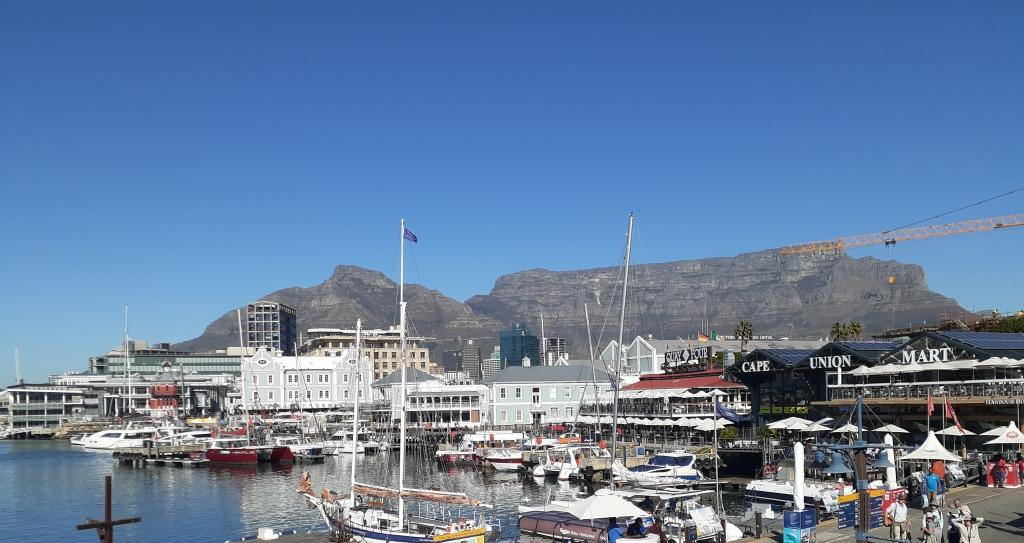
Table Mtn viewed from the Victoria & Alfred Waterfront precinct
Instead of going up Table Mtn, we chose a half day tour down to the Cape of Good Hope itself. Our tour provided driver proved to be very knowledgeable about the history of the region.
Shark Spotters are employed on the cliffs overlooking the Cape's surf beaches
A regular Cape villain- not to be engaged!
Its always a very windy and dangerous place with many shipwrecks just off the coast
That evening we had a team get together and then a meal at a local black African restaurant with delightful local music very reminiscent of a West Indian steel band. We got our first opportunity to try local game meats.
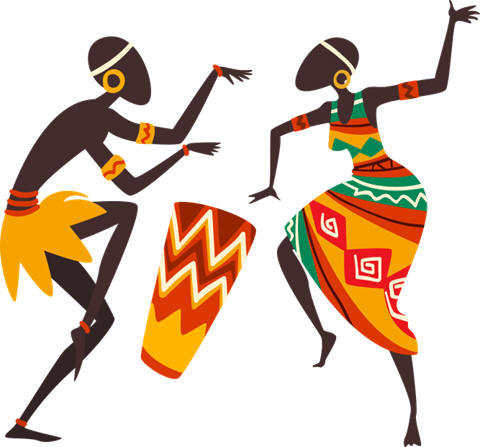

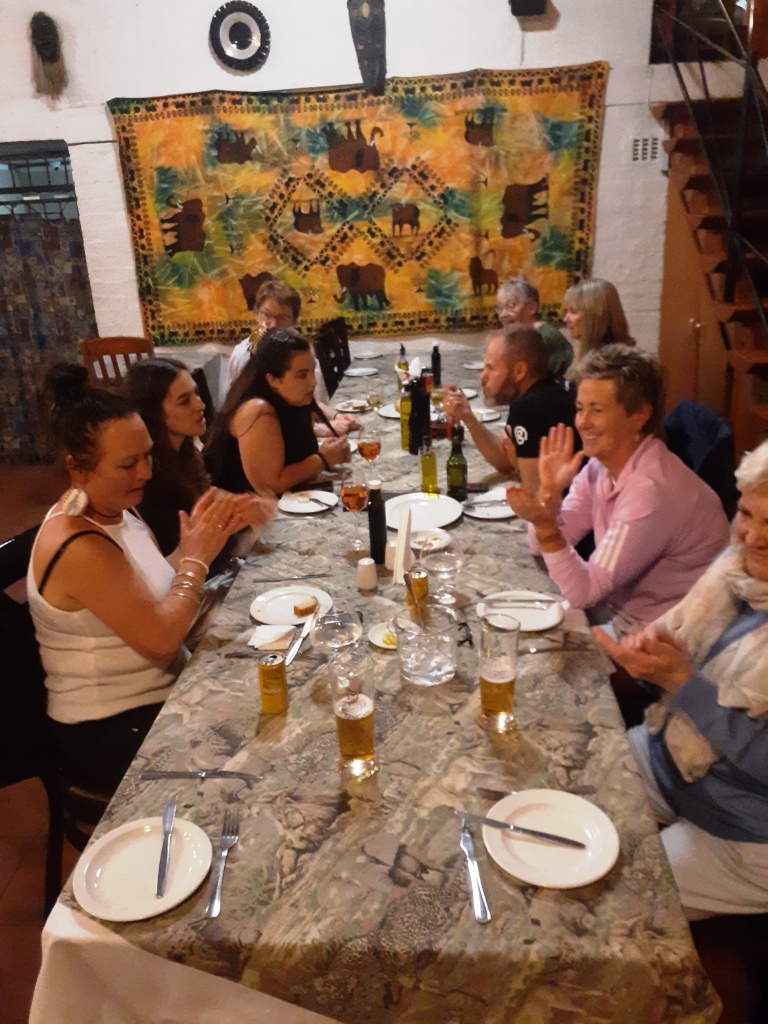
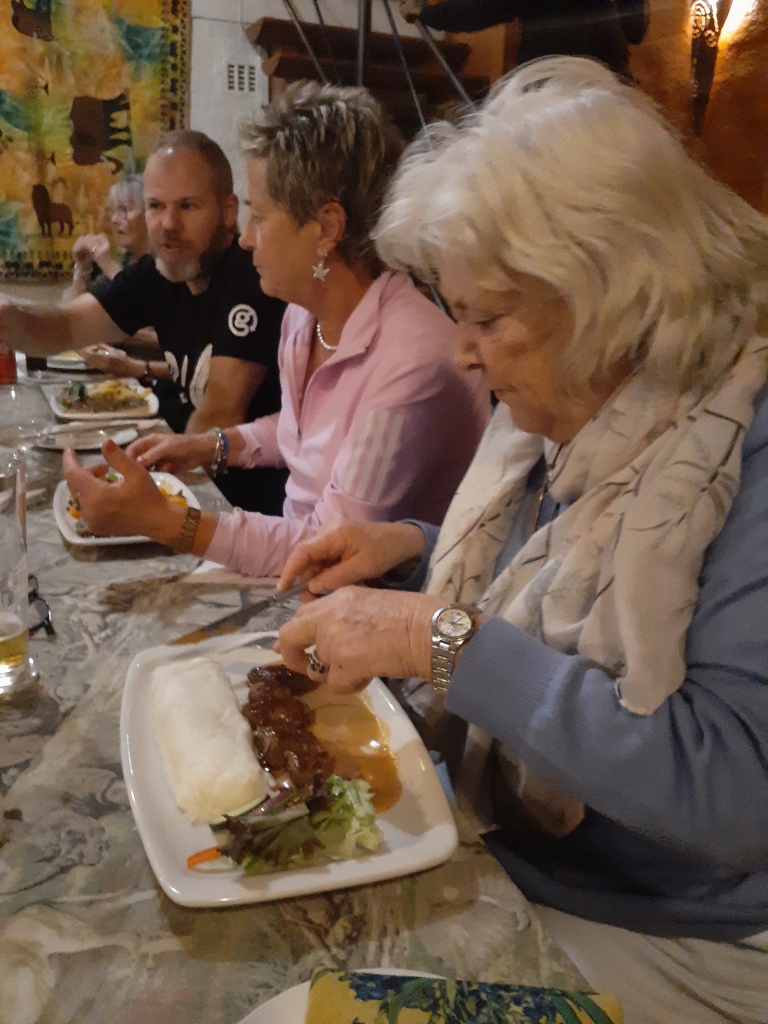
Our first group meal together: Geraldine (Ire), Abbie (UK), Tara (UK), Joan (Ire), Sarah (Ire), Leah (Aus), Gert (SA), Creena (Ire) while Maria tackles her Ostrich kebabs
The next day was designated free day so after a perusal of the artifacts and souvenirs on sale at the market outside our hotel, we rook a taxi down to the V & A Waterfront district which today is home to a variety of high end shops, restaurants and bars catering primarily to tourists not least of which pour off the constant stream of cruise ships which dock nearby. We had an interesting lunch at a seafood restaurant and tasted one of their premium table fish Kingklip (a fish caught in deep waters off the coast) and drank one of the finest beers available - Windhoek Lager from from Namibia. We did notice an Irish Bar down at the Waterfront and wondered whether or not a certain Irishman in Brisbane may have dropped in here when last he docked.

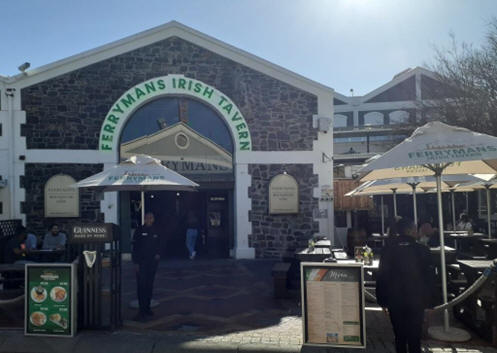
Johannesburg (population 6.3m)
Next morning we were all herded onto a bus to the airport for a Sth African Airways flight to Johannesburg. Security was everywhere. On approach to Johannesburg (Joburg), one flies over extensive irrigated farmland, then the extensive coal and gold mines which have provided so much wealth and employment to the population.
The flight took less than two hours but the rendezvous with our dedicated 22 seat coaster bus took almost as long. Loaded up with luggage Maria did not take kindly to traversing the labyrinthine O.R. Tambo International Johannesburg airport without ready access to wheel chairs or travellators. Fortunately GP noticed her distress and was able to assist. While in the airport we were advised to shop for 5lt bottles of drinking water as well as any other drinks snacks we might need for the bus trips ahead. I bought 3 x 1lt bottles of Tonic Water as had the Irish Girls - maybe an outbreak of malaria was anticipated.
Our bus then took us out to tour SOWETO the infamous South West Township some 50 odd kms from the airport. Soweto was initially created as a shantytown of black squatters dispossessed from their homes in Joburg via apartheid in the 1930s. It gradually expanded to become the largest black city in South Africa - today its suburbs are home to over 3million people. Tourists visit the town to learn first hand accounts of how apartheid impacted the black population. They also come to pay homage at the family home of Nelson Mandela and Hector Peterson. Our tour group was given their tour while on a bicycle ride around the town (we did not participate) but followed in the bus. Outside the Mandela home an indigenous dance troupe entertained us with a very exuberant exhibition of traditional dances.
Soweto was where active popular protests against apartheid took off in 1976 and over the following 12 months which saw the police killing over 570 black Africans (1/4 of them being school children). Prior to this, inter-racial marriage had been banned in 1949, ANC leadership had been jailed in 1962, over 3.5million black Africans had been forcibly removed from designated white areas to shanty townships such as Soweto and stripped of citizenship.
Old Soweto housing without power or running water and the housing in the new Soweto
While the Irish contingent paid their respects at Bishop Desmond Tutu's home the rest of us enjoyed the roaming troupe of traditional dancers
On our return journey to Joburg, GP gave us an additional talk about what he saw as the real intention of these shanty towns which was not only to clear the black population from the cities but also to ensure that they were essentially removed from centers of education and employment ensuring that their prospects for advancement in their own country were were further disadvantaged. Successive Afrikaan governments have prioritised the building of motorways at the expense of public transport systems. The railway system is simply not maintained. Owners of trucking companies have the ear of government when it comes to the haulage of goods including coal, one of the biggest commodities. While major reforms were initiated in the decade following Mandela's ascendancy to the Presidency, these initiatives have been seriously compromised in the two decades since 2000 with the ANC seen to be riddled with cronyism and sinister meddling by several overseas based companies and governments. The election of a coalition government in 2024 has many hoping for a return to truly democratic reforms and initiatives designed to improve the actual living conditions for the majority of the people.
That night we found ourselves lodged in yet another Omino hotel this time Omino Sandton, adjacent to the glittery Nelson Mandela shopping mall. This time round the hotel rooms were even tinier than in Cape Town with standing room only available around another unjustified king size bed. Maria decided to complain and we were simply moved to a family room with 3 beds - which provided a space at least to place the suitcases off the floor. These slick newly renovated hotels are fond of providing only one chair, no suitcase benches, no usable desk space but KING SIZED beds!.
GP had selected a bar restaurant for dinner which included a discreet rear bar with velvet upholstered booths at which sat a number of very smartly-dressed women in each smoking hookahs while their male friends all enjoyed a alcoholic drink. GP reckoned they may have been Muslim women who usually did not consume alcohol; at least not in public . It was here that I had an incident with a drinks waiter who wanted me to tip her in advance of having the drinks delivered......unfortunately, the national custom of tipping for everything is alien to our own modes operandi.
On Safari - at last
On our drive north out of Joburg we witnessed first hand the traffic gridlock which plagues Joburg every morning and night. As far as the eye could see traffic banked up in all directions. After some serious consultations with GP, our driver decided it would be better for us to take the 'grand circle route' around both Joburg and Pretoria to link up with our route into Kruger National Park via Lydenburg and Blyde River Canyon . Here we took a break from our bus to clamber down to examine the polished stone walls of this canyon.

Blyde River Canyon
The Potholes
It was then on to our final destination at Hazyview Resort just outside one of the the southern gate entrances to Kruger National Park - it had been the first of many tiring 1o hour bus rides - this resort offered glamping in large ensuited marques/tents beside the swift flowing and picturesque Sabie river.

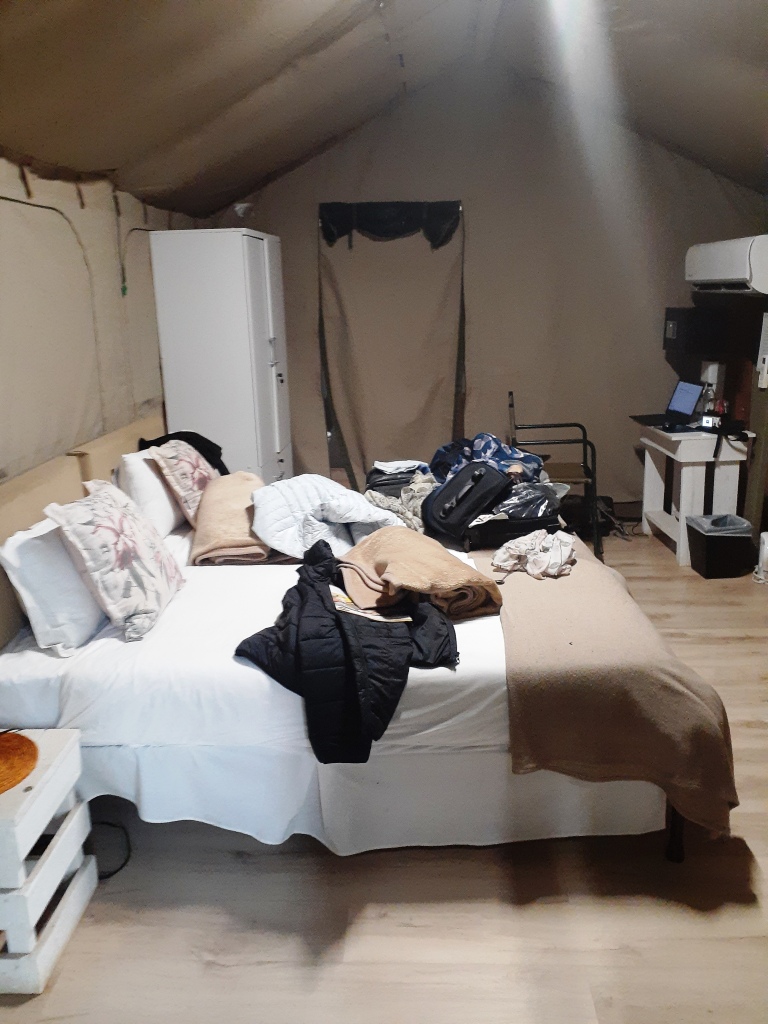
Five o'clock drinks were most welcome in anticipation of entering Kruger the next morning. GP had raised our expectations of sighting The Big Five 5 - (Elephant, Lion, Leopard, Buffalo & Rhinoceros) in this park.
Kruger National Park
We had to be up at 0430 hrs next morning to ensure we were at the Kruger NP entrance gate before sunrise. We were transported there in two open 4x4 Hilux jeeps and were provided with an assortment of blankets and ponchos to protect us from the freezing early morning temperatures. The NP was established in 1926 and was 350km long by 60kms wide and one of the largest conservation areas in the world, the speed limit throughout is 60/40kph on bitumen/gravel roads.
The NP covers an area of 19,485 square kilometres and stretches over the provinces of Mpumalanga and Limpopo. It is roughly the same area as Kakadu NP in the Northern Territory of Australia. Collectively, the unfenced private reserves of Greater Kruger cover an additional area of 1,800 square kilometres of land dedicated to conservation. Kruger National Park is a state-owned national park. Whereas, the Greater Kruger is made up of a group of private game reserves. Trophy Shooting is still permitted in a small number of private concessions but must be reliant on their own bred animals. Hard to believe that during the latter half of the 19th C and early 20th C well-connected gentry including members of the British aristocracy bragged about bagging 100s if not 1000s of Elephants, Lions and Leopards during their trophy safaris.
Movement of travelers between the two areas is restricted because the Greater Kruger and Kruger Park operate as two independent ecotourism destinations. Wildlife can now move freely between the two wilderness areas. Guests staying at a private game reserve in Greater Kruger can freely visit the Kruger Park while the reverse does not apply. Access to the private reserves of Greater Kruger is restricted to paying guests. Greater Kruger safari operators have unrestricted access to the public roads of Kruger Park. That said, to access Kruger National Park from the Greater Kruger, your guide has to drive you to one of the Kruger Park entrance gates i.e., there is no short-cut road through the private reserves to Kruger Park. In general, Kruger National Park is anything up to an hour’s drive from the private reserves of Greater Kruger. The Greater Kruger is a much more exclusive area. The safari lodges and camps offer an intimate safari experience. And, the camps and lodges are not governed by national park rules. This means that unlike Kruger National Park, in private game reserves guides can drive off-road, do night drives, bush walks, and bush breakfasts/dinners etc.
Apart from fellow tour group jeeps there are many local day trippers who enter the park in their private vehicles and camp and caravan in designated areas within the park. However, they are subject to the same rules and no one is permitted to leave their vehicles.
Our first day on safari yielded an unbelievable array of wildlife species; including three of the Big 5. One had to constantly remind oneself that these were wild animals and that we were not simply being driven around an extremely well-stocked zoo.
An early and freezing morning start
Yellow Billed Hornbill Vulture
Young Bull Elephants at Play in the early morning light
Snaps of Behinds - Zebra, Warthog and Buffalo
Mating pair of Lions (NB Scrawny appearance of male due to mating commitments)
Greater Kudu - Impala - Nyala
At the Waters' Edge - Elephant (and Crocodile) and Hippopotami
Timbavati Private Game Reserve
The following morning we, were driven to the Timbavati Safari Lodge. Here we were greeted with a welcome glass of sherry (how British) and accommodated in colourful traditional rondel styled accommodation cabins.
We undertook a bush walk in the evening examining the traditional medicinal and other uses of the local vegetation. We also learnt not to drive over elephant dung because of the long (5+cm) acacia thorns it contains and which can readily puncture jeep tyres.
Game-proof fencing and repaired breaches
Thorns of the Acacia Nigrecsens Tree (Knob Thorn) so beloved by Elephants, Giraffe & other herbivorous species
During pre dinner drinks that night, a number of Zebra, Warthog and Wildebeest wondered through the resort - we were getting rather blasé about the presence of such animals and so nobody thought to stop drinking.
Beautiful African Sunset
Dinner that night was served in a spectacular round open air dining room - alas the food which was purported to be BBQ beef turned out to be more braised beef and three vegetables.
We, but not the wily Irish contingent (it was the Sabbath after all), had signed up for an additional freezing morning safari which necessitated yet another 0430hr wake up and collection of packed breakfast box of fruit, yoghurt, sandwich and juice. We were now competing with school holiday visitors for early entry to the Timbavati Private Game Reserve. Despite arriving at the entry gate in the dark we had to join a sizable queue of vehicles and wait for nearly 45mins as our entry passes were processed. The highlight of this morning was the sighting of a Lioness moving her cubs in her mouth to another location along a riverbank - all under the watchful eye of her male partner. Now we learnt that adult male Lions forego eating during the mating season concentrating his energies towards Lioness's in season rather than hunting and will often appear quite emaciated during these times.
Daybreak at the NP Gate
All looking for a breakfast nibble on some Acacia Thorns
Now all the safari jeep drivers are in radio contact with one another and news of a Lion sighting spreads quickly and before you know it your experience can very quickly be shared with 10 or more other jeeps filled with excited visitors. We were advised that there are over 100 registered jeep drivers each contracted to different safari lodges and operators. There are of course many others operating exclusively inside the restricted private game reserves.
Back at the lodge we were all herded back into our coaster bus for a short journey further north to Lalapanzi Hotel near the town of Louis Trichardt in the most northern province of Sth Africa -Limpopo. Now Limpopo is named after the Limpopo River which forms the border between Sth Africa and Zimbabwe. Of course, for years the term 'up the limpopo' had been used disingenuously to imply an unknown location and so I was pleased to have at last been able to put an accurate geographic marker to the term. This hotel and accommodation units would not have looked out of place in rural England with its white washed walls and thatched roofs and the interior furnishings resembled that of an English pub....perhaps even Fawlty Towers.
Dinner is served at Lalapanzi Hotel - Sarah, Creena, Joan & Leah and then Tara, Abbie, Geraldine, JWB
Of particular interest to Australian visitors is the small museum dedicated to the Boer War and to Harry (Breaker) Morant. In fact the museum seeks donations towards having Morant and his fellow participants granted posthumous pardons for their convictions of murder for which they were executed. An interesting display. I was somewhat amazed by the fact that we were the only people in our group who knew the story let alone who had seen the film dramatisation starring British actor Edward Woodward.
Our challenge the next morning was to expeditiously cross the border into Zimbabwe. We were warned it could take hours and that we were all to follow any instructions directed at us and to be vague about occupations and to avoid terms such as journalist, writer, soldier etc)....of course one of our Polish contingent put down 'editor' which did not go down well. Suffice to say it took 3 hours of waiting in the hot sun and cost A$45 each for a double entry visa. I declared myself to be 'a retired bureaucrat'.....worked a treat! During our trials at the customs post we remained under the watchful eye of a family of Baboons perched up on the roof.
En route to the border the N1 motorway (forms the first part of the Cape to Cairo transport link) ran along a very high electric fenced property for some kilometers protecting an exclusive estate owned by the Prince of Saudi Arabia complete with private airstrip capable of landing large commercial jet planes - we never saw him. At the border we had to change buses and driver as our original transport was scheduled to return to Joburg.
Zimbabwe
Baobabs in Zimbabwe Limpopo River
Immediately crossing into Zimbabwe you notice a fall in municipal standards of the roads and townships. In fact the roadsides are just littered with plastic bottles and other debris. The road forks at the border with one branch headed to the capital Harare (485km) and the other other to Bulawayo (340km) - we followed the latter towards Clevers Lakeview Resort overlooking Lake Mutirikwi. The road was badly pot-holed and poorly constructed judging by the wafer thin strip of bitumen that had been lain down. Many Baobabs (tree of life) growing here. More trucks and buses than cars on the road each weaving around the damaged road or just driving on the dusty gravel shoulders. A lot of subsistence farming going on with goats plus the odd banana, papaw and mango trees clustered around their traditional round mud houses with the thatch roofs. People appear resigned to walk when there is no bus - very few pushbikes let alone scooters sighted.
Clevers Lakeside Resort was built on a very steep hillside covered in the most luxuriant gardens we had so far seen in Africa. The gardens were similar to that seen in the Top End and Far North Qld tropics. This resort was used only as a rest stop and we left the next morning for the Zimbabwe's second largest city of Bulawayo (population 1.5million) where we stopped briefly to stock up at a supermarket for lunchtime snacks to carry us over for the next couple days. This proved a little difficult as we have had no certainty of refrigeration in any of our rooms since we left Joburg. We managed some rolls and ham, cheese and local Venison Jerky (very popular). However our compatriots adopted the more cautious route of opting for biscuits and chips.
The real task for the day was to learn about and explore the Great Zimbabwe Monument area - Africa's most significant ruins' site south of Egypt. This was the most strenuous undertaking of the whole tour and GP wisely counseled Maria not to attempt it. Nevertheless it was a fascinating experience and one none of us would have missed notwithstanding the sore knees afterwards. I must say I was impressed by the stamina displayed by Tara, Abbie and Leah in clambering up and over this historical rock pile......ah youth!

Innocent Observer
Unfortunately, at the time of our visit there was a power outage at the Monument's museum preventing a comprehensive understanding of this UNESCO registered site. (The local guide had to resort to the light in a a borrowed Mobile to try and display the exhibits). As a consequence I have incorporated the following extract from a National Geographic article sourced from the internet.
Great Zimbabwe
Great Zimbabwe was a medieval African city known for its large circular wall and tower. It was part of a wealthy African trading empire that controlled much of the East African coast from the 11th to the 15th centuries .
Great Zimbabwe is the name for the stone remains of a medieval city in southeastern Africa. It is composed of three parts, including the Great Enclosure . It is believed to have been a royal residence or a symbolic grain storage facility.
Great Zimbabwe is the name of the stone ruins of an ancient city near modern day Masvingo, Zimbabwe. People lived in Great Zimbabwe beginning around 1100 but abandoned it in the 15th century. The city was the capital of the Kingdom of Zimbabwe, which was a Shona (Bantu) trading empire. Zimbabwe means “stone houses” in Shona.
Great Zimbabwe was part of a large and wealthy global trading network. Archaeologists have found pottery from China and Persia, as well as Arab coins in the ruins there. The elite of the Zimbabwe Empire controlled trade up and down the east African coast. However, the city was largely abandoned by the 15th century as the Shona people migrated elsewhere. The exact reasons for the abandonment are unknown, but it is likely that exhaustion of resources and overpopulation were contributing factors.
The archaeological site at Great Zimbabwe consists of several sections. The first section is the Hill Complex, a series of structural ruins that sit atop the steepest hill of the site. This is generally believed to have been the religious center of the site. The Hill Complex is the oldest part of Great Zimbabwe, and shows signs of construction that date to around 900 C.E.
The ruins of the second section, the Great Enclosure, are perhaps the most exciting. The Great Enclosure is a walled, circular area below the Hill Complex dating to the 14th century. The walls are over 9.7 meters (32 feet) high in places, and the enclosure’s circumference is 250 meters (820 feet). The walls were built without mortar, relying on carefully shaped rocks to hold the wall’s shape on their own. Inside the enclosure is a second set of walls, following the same curve as the outside walls, which end in a stone tower 10 meters (33 feet) high. While the function of this enclosure is unknown, archeologists suggest it could have been a royal residence or a symbolic grain storage facility. It is one of the largest existing structures from ancient sub-Saharan Africa.
The third section is the Valley Ruins. The Valley Ruins consist of a significant number of houses made mostly of mud-brick (daga) near the Great Enclosure. The distribution and number of houses suggests that Great Zimbabwe boasted a large population, between 10,000–20,000 people.
Archaeological research has unearthed several soapstone bird sculptures in the ruins. These birds are thought to have served a religious function, and may have been displayed on pedestals. These birds appear on the modern Zimbabwean flag and are national symbols of Zimbabwe.
A fact sheet or brochure should have been made available to us prior to visiting this sight. It was encouraging to witness a group of very smartly dressed (private) school children participating in a school excursion to this historic site.
Matobo National Park
We eventually drove into the Farmhouse Resort in the Matobo National Park - this park was named by an ancient Zulu warrior who named the huge granite outcrops Matobo meaning 'bald heads'. Cecil Rhodes gained permission from the local tribes to be buried atop one of the outcrops and Lord Baden Powell was inspired, while stationed here, to develop the boy scout and girl guide movements.
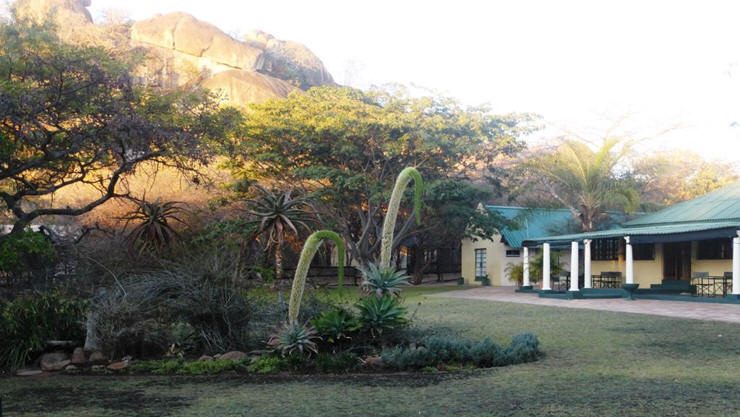
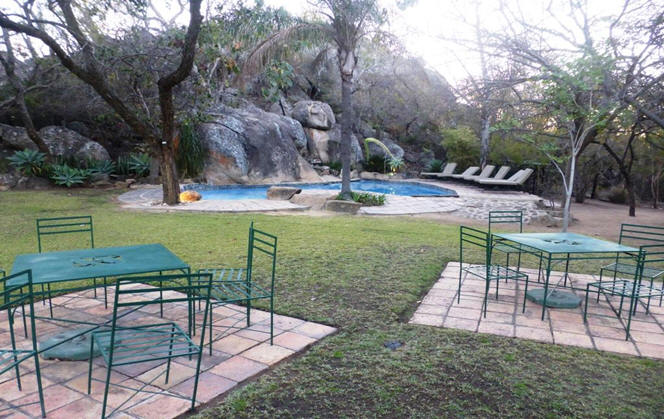
That afternoon Maria and I joined the lodge manager's wife for a 3 hour tour of their own unfenced wildlife reserve where we spotted many Antelope, Zebra and Giraffe. She also pointed out the distinctive pads of a large Leopard. She explained that Leopards are always difficult to sight on account of their dens are generally quite inaccessible amongst rocky outcrops and that they generally drag their killed prey back to their dens to share with their cubs. They rarely remain out in the open as do Lions. She also drove us to a lookout point where we could look over the majestic granite boulders which are scattered throughout the parks.
Purported tracks of the phantom 'Big 5' Leopard
That night the Lodge put on a real BBQ or Braai cooked over the coals out in the grounds beside a very big fire pit. I had been calling for such an experience and good old GP persuaded the management to put it on before we left. It was a great night made better by a couple of bottles of local red wine Pinotage and Cabernet Sauvignon.
Next morning all, but Maria, joined a local African guide to view a number of galleries of ancient cave paintings situated under a number of rock ledges. Matobo hosts one of the largest collection of cave paintings in Africa and are estimated to be over 13 000 years old. These were similar to those one can see in the Cape York, Kimberley regions and Kakadu NP in the Top End of Australia but perhaps not as well preserved as the later - perhaps they were older but the old fellow could not advise on this.

Later, in the afternoon we were collected by an experienced safari tracker guide (John) who took us out into the NP to track down some White Rhinoceros who were known to inhabit a particular area. John eventually met up with two local park rangers armed with AK47 rifles who had tracked the animals earlier. We were then allowed out of our jeep to track down the animals on foot. Silence was commanded and so in single file we lightly tramped around the scrub for 20minutes or so until we caught a fleeting glimpse of a mother and baby Rhino.
However, they quickly caught sense of us and bolted but the trackers were convinced they knew where they had gone and so we returned to the jeep to head down to the new location. This time Maria also go out of the jeep to renew the trek and sure enough we again met up with the two rangers as well as the two Rhinos - what an experience!
The happy big game hunters
Bingo - 4.5 of the Big 5.......bragging target sort of met!
The rangers were deployed 24/7 in the NP to deter poaching. They are authorised to shoot poachers on site. Following our 'successful hunt' John pulled out an esky from his jeep and distributed Wine and beers to our group. Great stuff.
Modern poachers have now resorted to drones and helicopters making the job of the rangers that much more difficult. As well the NP employs a program of Rhinos horn removal to deter the poaching of these animals. We were told that it was only after the intervention of such conservation measures that Rhino numbers are at last beginning to increase after previously been threatened by extinction. Despite the 1990 International Ban on trade in ivory, African Elephant numbers continue to decline albeit at a much slower rate.
Hwangi National Park
The drive north east to the Hwangi NP took us over some of the worst roads of the tour.
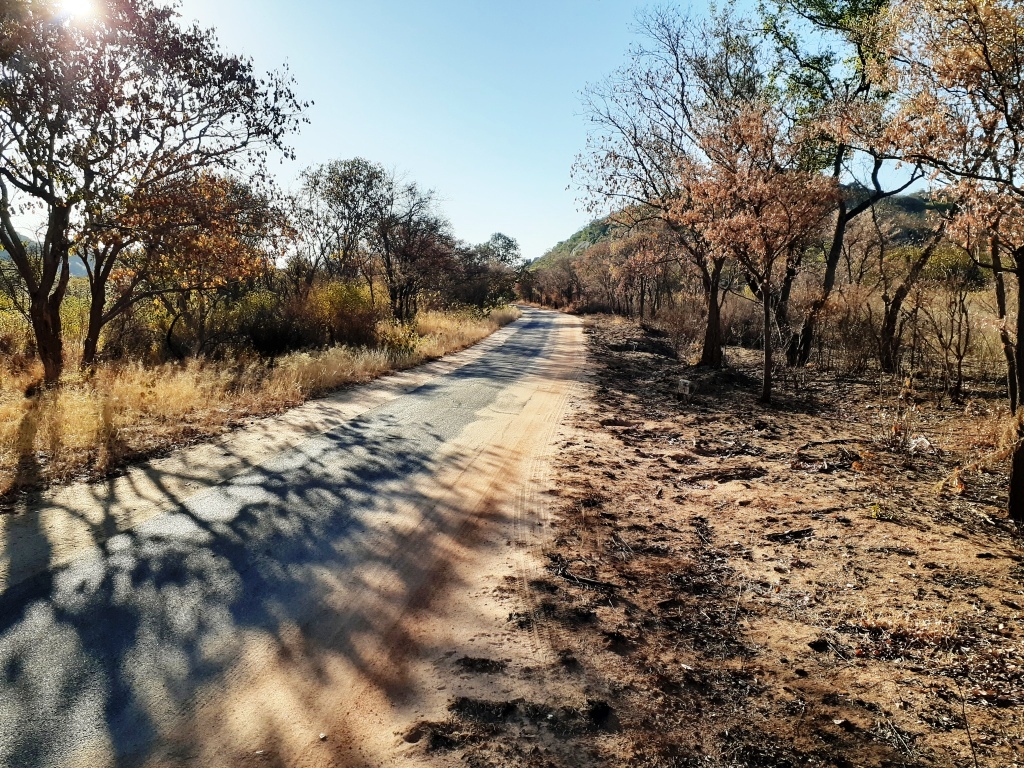
It took nearly 7 hours to cover the 300kms involved. As a consequence there were no takers for the optional extra safari in the afternoon. This reluctance could also be partially explained by the opulent newly renovated Hwangi Safari Lodge we had been billeted in. It was superb and the wildlife that congregated at its 'home waterhole' was like something out of a Disney film clip. The waterhole would have been no further than a couple of hundred meters from the swimming pool terrace and was floodlit at dusk to attract even more wildlife viz large families of trumpeting Elephants, Baboons, screeching Vervet Monkeys, Vultures and Marabou Stork or Undertaker Bird. Lions had been sighted drinking at water hole just prior to our arrival.
Maria and GB enjoy an evening drink Marabou Storks (aka Caretaker Birds) which feed off carrion)
That evening marked the Winter Solstice in South Africa accompanied by an almost Full Moon
To celebrate this ringside view we all agreed to dine al fresco that night. While Warthog was on the menu unfortunately it along with all game meat options had been consumed before I was able to order.
Victoria Falls National Park
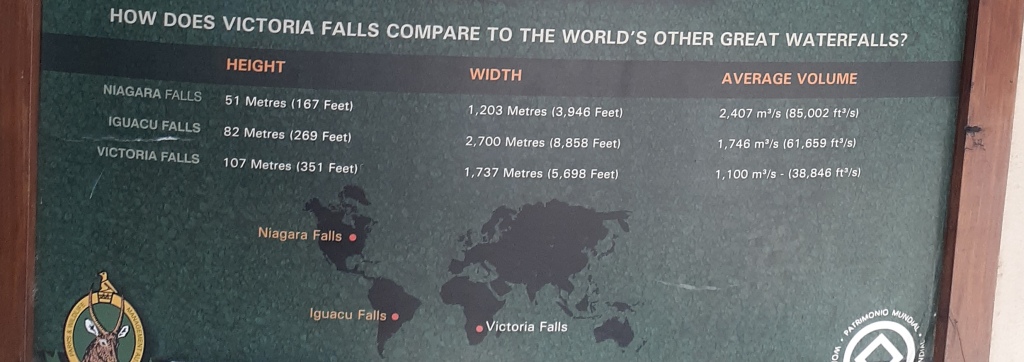
Today we at last drove the last 100km into Victoria Falls NP. GP had arranged NP entry permits (US$50/each) for all of us which gives one access to a 3.5km viewing track opposite the Falls. One can hire ponchos to protect yourself from the considerable spray - but I found the spray half way around the track was seriously compromising any photography one wanted to take and so turned back. Following our introductory walk around the Falls we were taken to lunch prepared by Lusumpuko Women's Club a charitable institution supported by G Adventures and which provides support and employment to women in the Victoria Falls region.
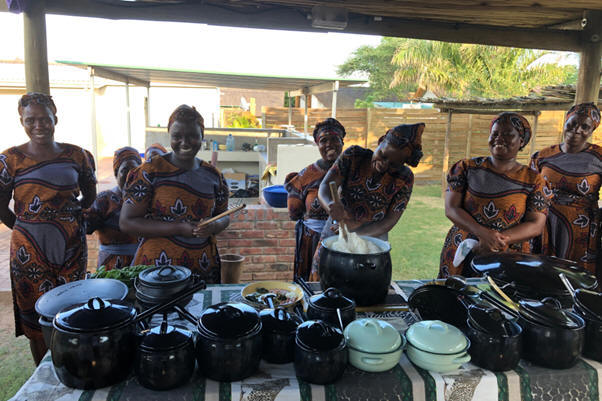
Our tour had booked us in to the Shearwater Explorers Village only 0.5kms from the Falls and which proved an ideal accommodation choice. The City of Victoria Falls is like no other in southern Africa being predominately dedicated to Falls tourism. Throughout the day one has to put up with the constant sound of helicopters overhead. Surrounding the entrance to the NP are a lot of tacky souvenir shops and hundreds of slick accommodation options, some with golf courses for you know who and others just offering tent spaces for intrepid hikers . However, it does have a busy international vibe not experienced elsewhere - maybe has similarities to Australia's own Gold Coast.
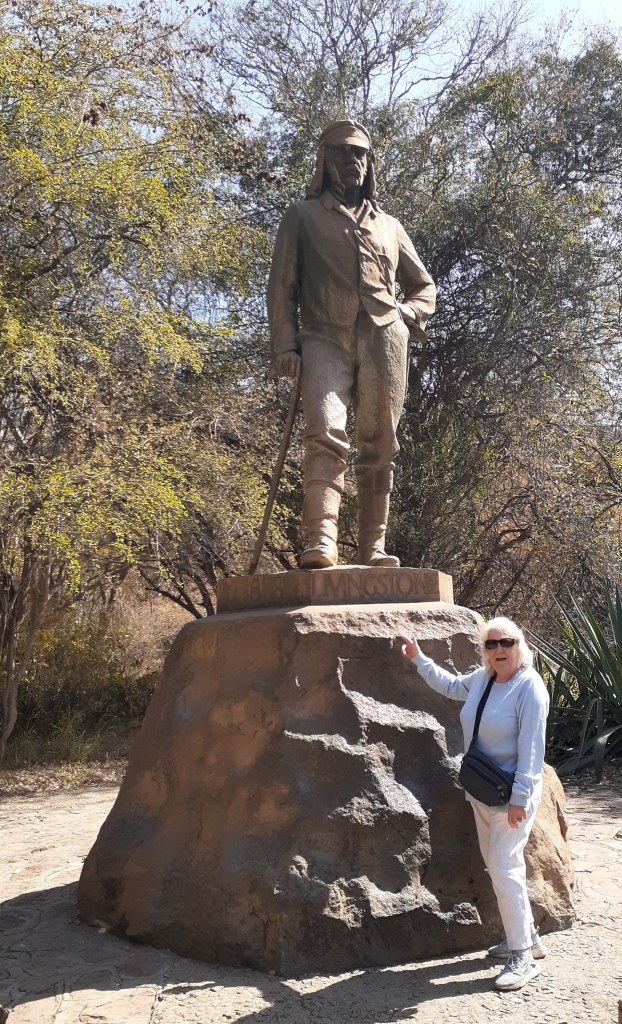
Paying our respects to Dr David Livingstone - first European to clap eyes on these Falls in 1855.
Options at the falls include:
![]() a boozy 2.5hr ferry ride up the Zambezi River to the base of the Falls
a boozy 2.5hr ferry ride up the Zambezi River to the base of the Falls
![]() a high speed jet boat ride across the top of the falls
a high speed jet boat ride across the top of the falls
![]() Bungee jump from the bridge
Bungee jump from the bridge
![]() fixed wing flight over the Falls
fixed wing flight over the Falls
![]() 14min helicopter flight over falls
14min helicopter flight over falls
We chose the latter and it was marvelous. For those interested, we had a video clip made of our helicopter flight over the falls and this has now been uploaded to You Tube and can be viewed by searching for YouTube on the internet and then click on the subscriptions option and then type: John Burchett/My HD Flight of Angels D21.mp4.and press Enter.
Arrival at Victoria Falls marked the official end of our tour but we agreed to have one final dinner together to say goodbye to each of our new friends and to GP who had proven to be an excellent CEO of our trip and had kept us reasonably coordinated and focused for most of the tour. During the dinner a couple of the Irish contingent had had a birthday cake made for one of their own as well as myself who were celebrating birthdays on the day. More excuses to drink a little bubbly. I was then nominated by the group to formally thank GP for his services and to hand over the proceeds of the whip around organised earlier in the day. A great night!


Chobe River National Park
For seven of us the tour had not ended as we had booked the optional extension of a trip into Botswana to undertake a further land and river safari in the Chobe River NP (part of the Okavango Delta). This involved an early 0700hr transfer in a transit bus to the border where we had to present ourselves at immigration posts for both countries. However, it was almost seamless and took minutes compared to the hours crossing into Zimbabwe days prior. Visas for one day cost nothing. As a bonus,all visitors are offered free condoms to help the country’s fight against the scourge of Aids.
Maria quickly found out, it was still bloody cold in the early morning in an open 4x4 jeep even tho we were now traveling around the 18 degree South latitude.
We were picked up in a now familiar safari jeep on the Botswana side and immediately driven into the NP only a couple of kms away. The tracks in this NP are all soft sand and very easy to drive on. Our guide once again was very skillful in finding a spectacular selection of Giraffe, Wildebeest, Warthog, Zebra, Antelope.
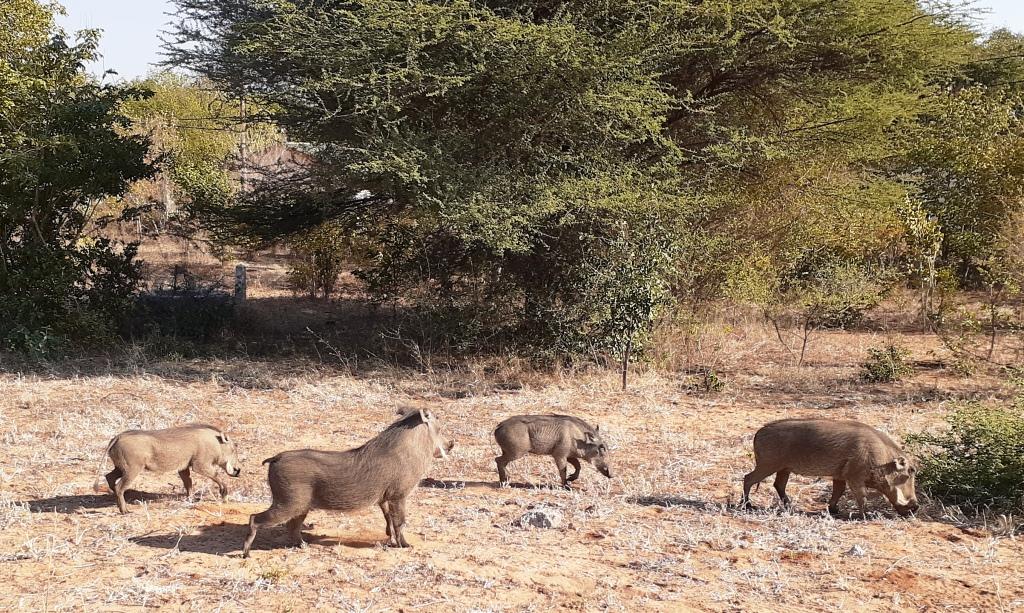
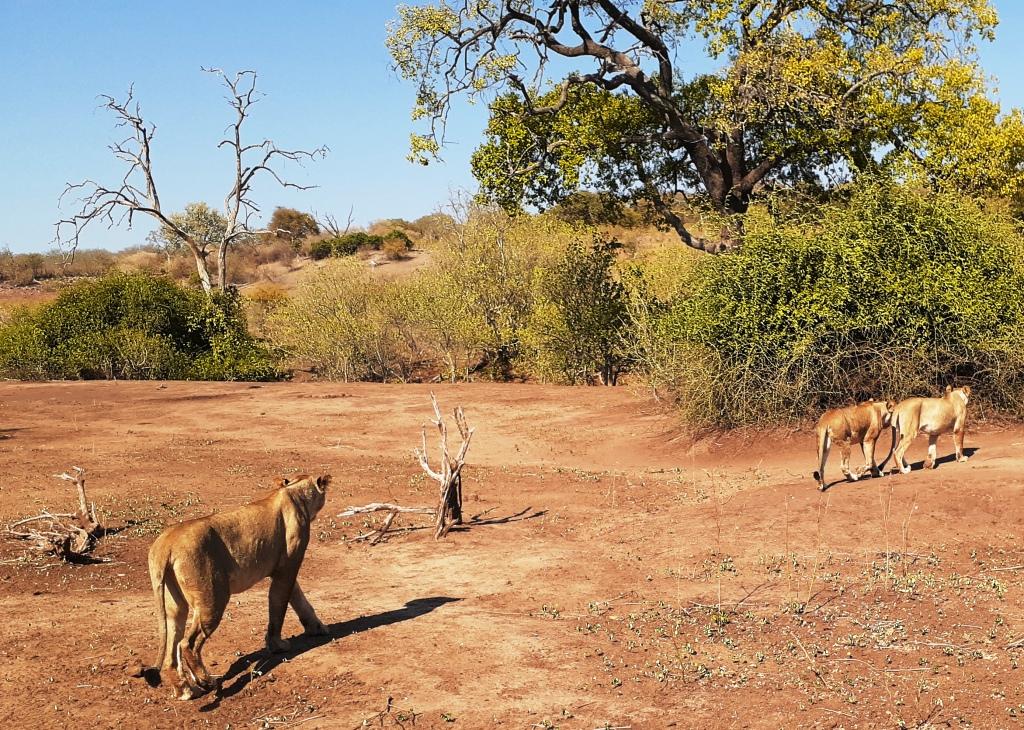
Warthogs (member of the Ugly 5) and pride of Lions


Family of Elephants and sad skeleton of a deceased member
Our guide was also able to drive a little off the tracks to surprise a couple of young Lions (brothers) taking a midday nap.
After a buffet lunch in a local hotel, 20 of us boarded a a large sightseeing boat with rooftop deck for a view of the wildlife residing in the river delta. This enabled us to get good and close to 2-4m Nile Crocodiles, Buffalo, and Hippopotamus. We also saw a number of Water Monitors, water birds such as cranes and Turtles.
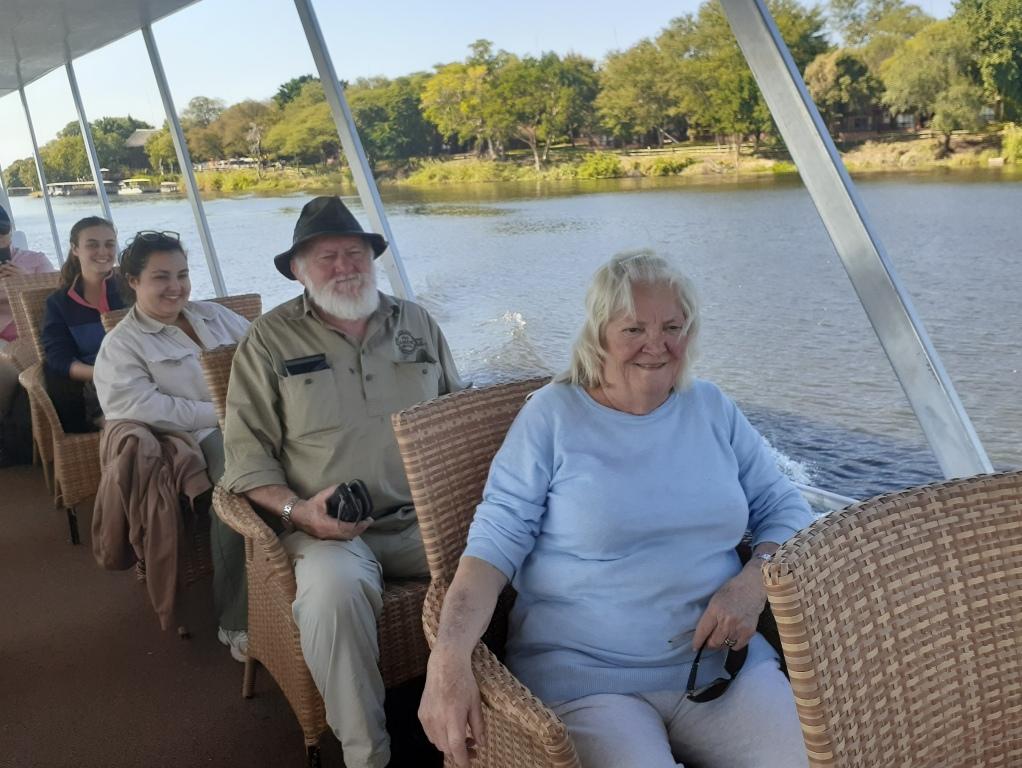
Abbie and Tara also braved this river 'cruisey' safari
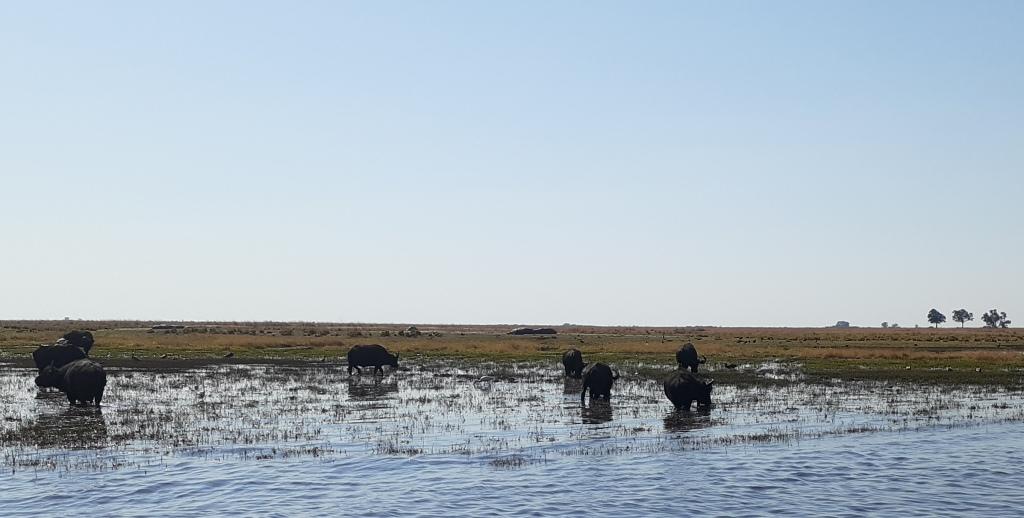

African Buffalo and Nile Crocodiles
A lot of Hippos
She had Right of Way
I do believe this was an excellent experience for folk not familiar with tropical wetlands but for us, apart from the Hippos, the river wetlands were similar to a a lot of Top End waterways.
Our last morning in Victoria Falls was spent shopping for gifts in an area known as Elephant Walk which is full of artifact shops as well as boutique art and craft shops. It was here at a very self conscious European styled cafe that we first encountered our first North American tourists since first setting foot in Africa. Here they were loud, impeccably dressed in twin sets, loafers, chinos baseball caps looking for all the world as if they had just jetted in from Aspen - not a speck of safari dust or dung to be seen - two of the women even had fluffy doggies on leads!...in a NP.
Back to Johannesburg and Home
We spent our final morning at the Elephant Walk markets in search of some bona fide bargains..........however, unbeknown to myself, I was also in possession of a bargain, after a stall holder made a pitch to purchase the battered shoes I had been wearing for the entire tour.
After much haggling we secured a couple of carved wooden mementos and a rather evocative batik styled wall hanging.
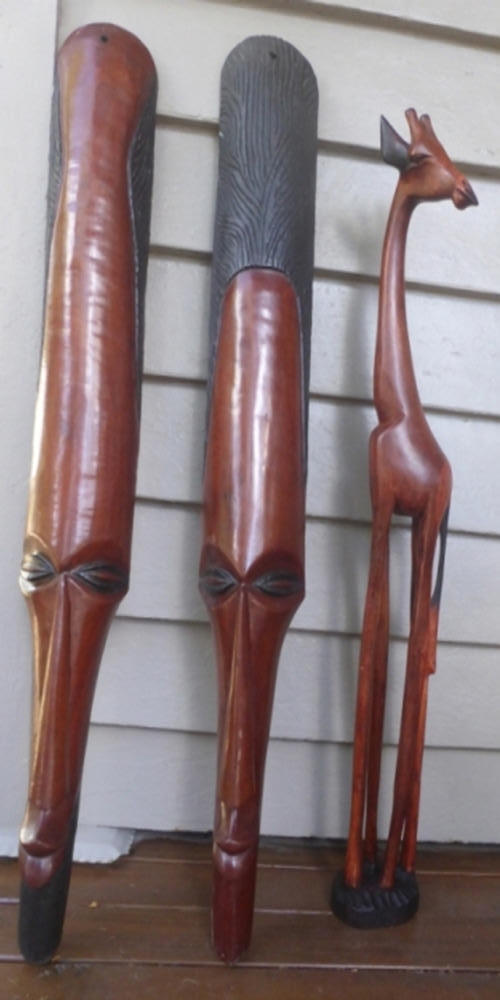
They have since made fine additions to our entertainment deck.
We then hurried out to the Victoria Falls Airport for the two hour flight back to Joburg and our rendezvous with the Marble Restaurant for my special birthday dinner. While our travel company's choice of airport hotel was again a big disappointment my chosen dinner venue was not. Memorable
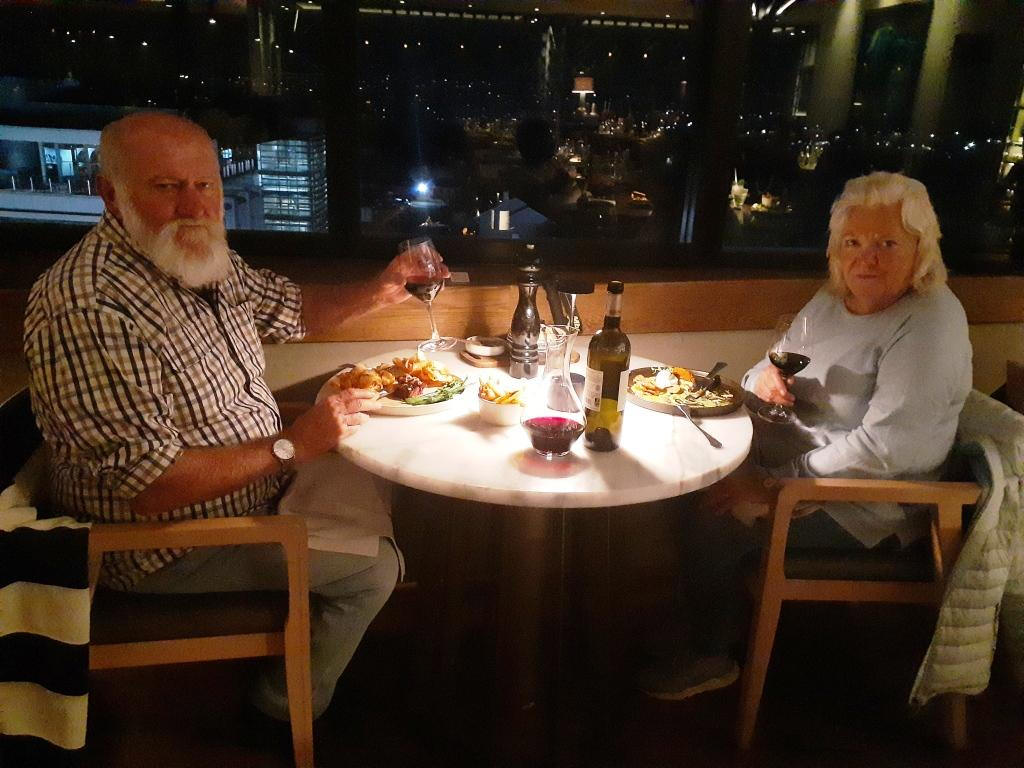
Celebratory Dinner at The Marble Restaurant with lights of Johannesburg twinkling below (while it cannot be seen, but my 400g Beef Rib Fillet unexpectedly came with a side of potato crisps as well as the regular vegetables)
The prospect of nearly 20 hours flying plus the inconvenient 4hr layover in Singapore was not a good way to end the holiday but there does not appear to be any easier method of getting to Africa from Australia. That said, I would still urge people to consider going; even if they just opt for the popular triangular tour of Cape Town - Kruger - Victoria Falls/Chobe NP over the same period of time but which is set at a more leisurely pace utilising four star accommodation and possibly 3-4 ply toilet paper.
Who knows where to next.